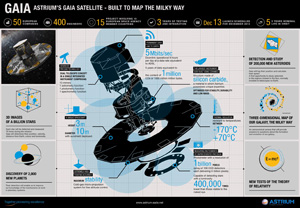 A poster presenting the main scientific goals and the key facts about the mission and the spacecraft. Courtesy of Astrium. Available as an image in JPG format (640 KB).
A poster presenting the main scientific goals and the key facts about the mission and the spacecraft. Courtesy of Astrium. Available as an image in JPG format (640 KB).
Description of the poster
The poster consists of three horizontal sections: top section, the main section, divided into three columns, and the footer.
Top section
The top section contains the title and a list of mission statistics, which include the following information:
- 50 European companies
- 400 engineers
- project involving 15 European Space Agency member countries
- 3 years of testing and integration
- launch scheduled for December 2013
- 5 years nominal life in orbit.
Main section, side columns
The two narrow side columns of the main section contain a photograph of the spacecraft and list the following five mission goals:
3D images of a billion stars: Each star will be detected and measured 70 times during the mission. Gaia will determine their position, velocity, distance from Earth, colour and luminosity
Discovery of 2,000 new planets: Their detection will enable us to improve our knowledge of the mechanisms at work in planetary systems.
Detection and study of 200,000 new asteroids: Gaia will log their position and calculate their speed. A first opportunity to study asteroids in the regions closest to the Sun, normally invisible to telescopes on Earth.
Three-dimensional map of our galaxy, the Milky Way: An astronomical census that will provide answers to questions about the formation and evolution of our galaxy.
New tests of the theory of relativity.
Main section, centre column
The centre column of the main section contains the diagram of the spacecraft and the following information about the satellite.
Advanced payload technology
Dual telescope concept in a single integrated instrument comprising:
- 10 mirrors
- 1 astrometry function
- 1 photometry function
- 1 spectrometry function
A unique spacecraft
- Height 3 m
- Diameter 10 m
with sunshield deployed.
Extremely high pointing accuracy
Maximum stability
Cold-gas micro-propulsion system for fine attitude control.
Permanent data link to Earth
5 Mbits/sec downlink operational 8 hours per day at a data rate equivalent to ADSL.
5 years of data equivalent to the content of 1 million CDs or 1000 million million bytes.
The largest instrument ever built using ceramics
Structure made of silicon carbide, a material in which Astrium possesses unique expertise.
Optimised for stability, durability and low mass
Thermal insulation
resistant to temperatures between -170°C and +70°C.
Measuring instruments of unprecedented precision
Photometer with a resolution of 1 billion pixels (array of 106 CCD detectors each delivering 9 million pixels).
Capable of detecting stars with a luminosity 400,000 times lower than those visible to the naked eye.
Footer
The footer contains Astrium logo, company website address, www.astrium.eads.net, and the slogan: “Together pioneering excellence”.
Page last updated: 23 January 2014
